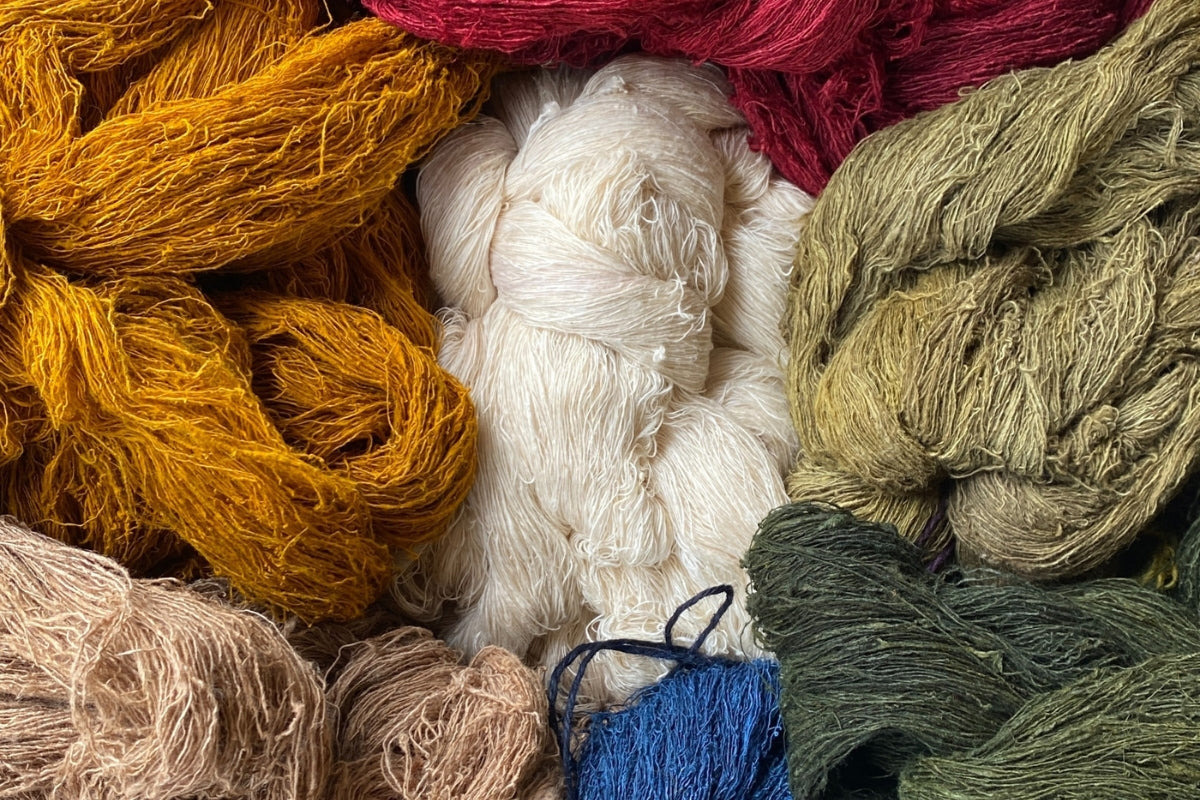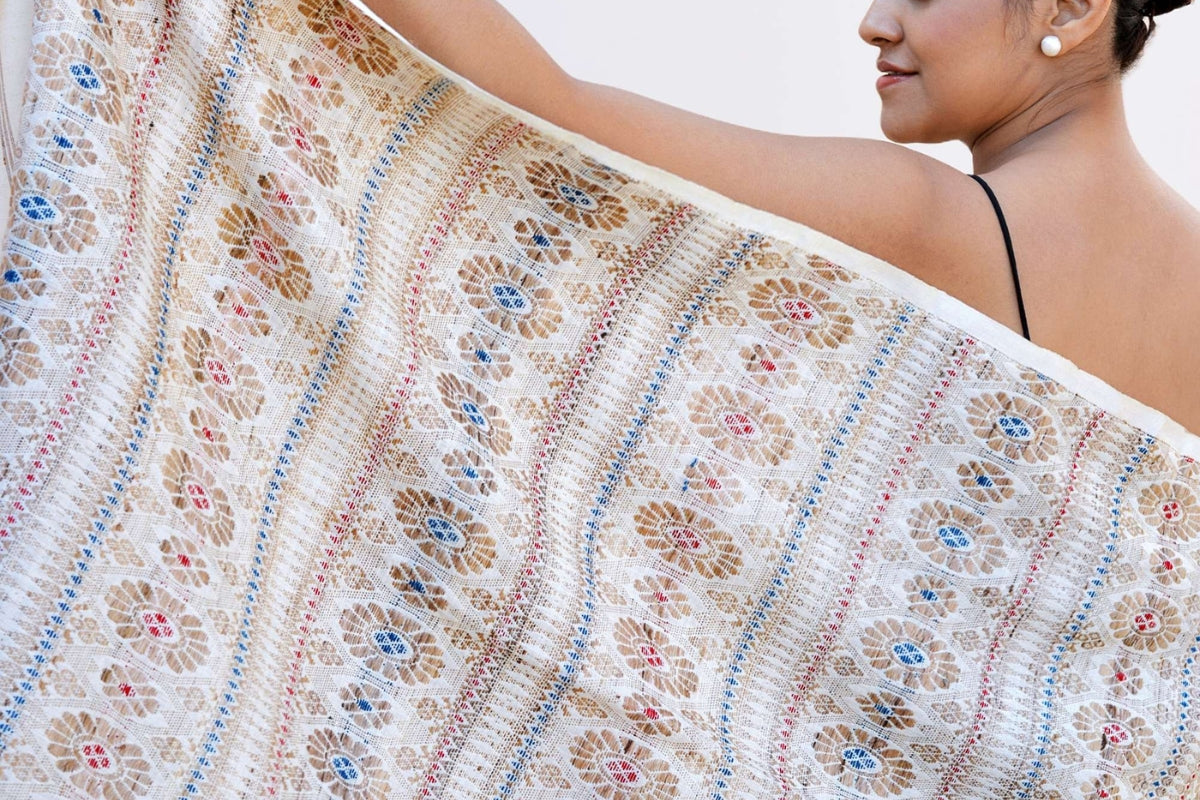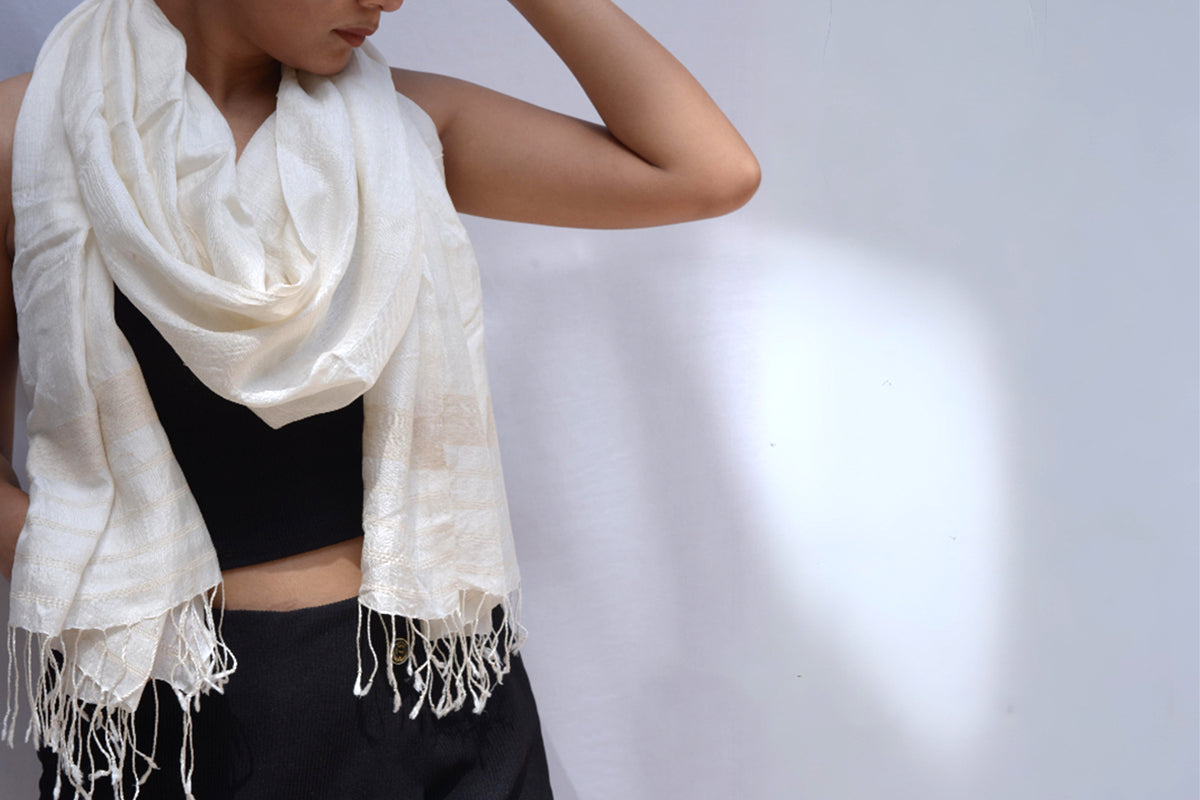Eri silk yarn is a remarkable textile that stands apart in both ethics and aesthetics. Known as "peace silk," this special fiber allows silkworms to emerge naturally from their cocoons before harvesting, creating a truly cruelty-free material.
The magic happens in the skilled hands of women artisans at Dzukou, nestled in rural Assam. These craftswomen transform raw Eri silk into exquisite yarn through traditional spinning techniques passed down through generations. Their expertise brings out the yarn's distinctive qualities:
- A soft, cottony texture with a natural matte finish
- Breathable, hypoallergenic properties
- Temperature-regulating capabilities
- Perfect for creating heirloom-quality pieces
Each skein of Eri silk tells a story of sustainable practices, ancestral wisdom, and artisanal excellence. When you work with this exceptional yarn, you're not just crafting - you're becoming part of a rich textile heritage that values both people and planet.

The Allure of Eri Silk: Its Beauty and Crafting Potential
Eri silk captivates crafters with its distinctive tactile qualities. The fibers create a fabric that feels luxuriously soft against the skin while maintaining excellent breathability. Its natural matte finish sets it apart from traditional glossy silks, offering a sophisticated, understated elegance that appeals to modern makers.
Why Choose Eri Silk?
The hypoallergenic nature of Eri silk makes it an ideal choice for those with sensitive skin. Its remarkable isothermal properties regulate temperature - keeping you cool during summer months and providing warmth in winter, making it perfect for year-round wear.

Endless Creative Possibilities
Crafting with Eri silk opens up endless creative possibilities:
- Knitting: Creates lightweight yet warm garments with beautiful drape
- Crochet: Produces intricate textures that hold their shape
- Weaving: Yields durable fabric with a distinctive rustic charm
The fiber's natural affinity for dyes allows crafters to achieve rich, lasting colors. Natural dye enthusiasts particularly appreciate how Eri silk absorbs plant-based pigments, producing:
- Deep forest greens
- Rich earth browns
- Subtle botanical grays
- Warm ochre yellows
These earthy tones complement Eri silk's natural character, creating pieces that reflect both environmental consciousness and artisanal heritage. The fiber's ability to blend seamlessly with other natural materials like wool and cotton adds versatility to any maker's creative palette.
Moreover, understanding the various types of fabrics, such as those detailed in this fabric checker guide, can further enhance the crafting experience.

 Understanding the Unique Process Behind Eri Silk Production and Its Versatility in Crafting Projects
Understanding the Unique Process Behind Eri Silk Production and Its Versatility in Crafting Projects
The journey of Eri silk begins with the remarkable Samia ricini silkworms, nurtured on castor oil plant leaves for approximately 50 days. Unlike conventional silk production, these silkworms create open-ended cocoons - a distinctive characteristic that allows the moths to emerge naturally. This ethical approach preserves both the silk's integrity and the silkworm's life cycle.
The production process reflects generations of local wisdom:
- Cocoon Collection: Harvesting occurs only after moths have emerged naturally
- Degumming: Gentle removal of sericin using alkaline soap and boiling water
- Hand Processing: Traditional spinning methods preserve fiber strength
- Natural Integration: Production cycles align with village ecosystems
Eri silk's unique fiber structure creates exceptional versatility in crafting projects. The staple fibers possess remarkable durability and natural elasticity, allowing crafters to experiment with various techniques. When blended with wool or cotton, Eri silk creates textiles with:
- Rich textural depth
- Enhanced drape
- Natural rustic aesthetic
- Improved thermal properties
The fiber's adaptable nature makes it ideal for diverse projects - from delicate lace shawls to sturdy everyday garments. Its natural crimp and staple length create strong yarns perfect for both intricate handwork and robust woven pieces.
This adaptability is further explored in detail in studies like this review on Eri silk spun yarn and fabric, which highlight its potential in various crafting applications. Additionally, the exploration of wild silks offers a broader understanding of the unique silk varieties, including Eri, that are produced through such sustainable practices.
 The Artisanal Connection and Sustainability of Eri Silk: A Material That Supports Craft and Community While Being Gentle on the Planet
The Artisanal Connection and Sustainability of Eri Silk: A Material That Supports Craft and Community While Being Gentle on the Planet
In rural Assam, skilled women artisans use traditional hand-spinning techniques to turn raw Eri silk into beautiful yarn. These craftswomen preserve ancient knowledge passed down through generations, with each thread representing their cultural heritage and artistic skill.
The Cultural Significance of Eri Silk in Assam
Eri silk holds great importance in Assam, both for special occasions and everyday wear. Local communities have incorporated silk production into their daily lives, creating a sustainable livelihood that empowers women while preserving traditional crafts.
The Sustainable Practices of Eri Silk Production
The relationship between Eri silk production and the environment is beneficial:
- Integration with Village Ecosystems: Eri silk production naturally aligns with local agricultural practices.
- Zero Waste Production: Every aspect of the process is either used or biodegradable.
- Minimal Resource Usage: Production requires little water and no artificial energy.
- Utilization of Local Resources: Castor plants, which are used in Eri silk production, grow abundantly in the region.
The Low Carbon Footprint of Eri Silk
Eri silk has a low carbon footprint due to its decentralized production model. Small-scale operations in villages eliminate the need for large factories or extensive transportation systems. The silk moves directly from artisan to maker, creating a close connection between producer and crafter.
The Unique Beauty of Hand-Spun Eri Silk
Each skein of hand-spun Eri silk carries the unique touch of its maker - subtle variations in thickness and texture that make every crafted piece one-of-a-kind. These natural qualities reflect both the skill of the artisan and the inherent beauty of working with materials produced in harmony with nature.
 Conclusion
Conclusion
The magic of crafting with Eri silk lies in its ability to connect makers with both their art and a larger purpose. Each stitch, weave, or knot carries the stories of women artisans in Assam, their traditional knowledge, and sustainable practices that protect our planet.
Dzukou's hand-spun Eri silk yarn invites you to create pieces that reflect your values:
- Ethical production that honors silkworms
- Natural, breathable fibers gentle on skin
- Support for rural artisan communities
- Environmental sustainability
Your handcrafted Eri silk pieces become more than beautiful accessories - they transform into meaningful expressions of conscious creativity. This special yarn brings soul to your crafting journey, whether you're making cozy scarves, delicate shawls, or intricate wall hangings. Choose Dzukou eri silk yarn to experience the true joy of making things yourself while being part of a larger story of craft, community, and care for our world.





